Abstract
(1) Background: Risk perception is a key factor in motivating people to comply with preventive behaviors during the COVID-19 pandemic. Appropriate risk perception is important to enhance beliefs and promote emergency management response to public health events. (2) Objective: This study developed a public risk perception measurement method for social media data to understand the dynamic characteristics of risk perception and emotional expression during public health emergencies. (3) Methods: Utilizing text-mining techniques and deep-learning algorithms, risk perception was calculated from two dimensions (dread and unknown) as well as the emotional expression characteristics of 185,025 posts from 10 January 2020 to 20 March 2020 on Sina Weibo. We also analyzed the characteristics of risk perception at different stages of the crisis life cycle. Furthermore, drawing on arousal theory, we constructed dynamic response relationships between emotion type (angry, fearful, sad, positive, and neutral) and risk perceptions by a vector autoregressive (VAR) model. (4) Results: The results revealed that the public expresses significantly more dread words than unknown words in shaping the risk perception process. As for the characteristics of evolution, public risk perception had been at a high level since the outbreak stage, and there was a sudden increase and a gradual decrease in the level of public risk perception. We also found that there is a significant response relationship between positive emotion, angry emotion, and risk perception. (5) Conclusion: This study provides a theoretical basis for more targeted epidemic crisis interventions. It points out the need for health communication strategy makers to consider the public’s risk perception and emotional expression characteristics during public health emergencies.
1. Introduction
In order to reduce the transmission of COVID-19, public protective behavior plays an extremely important role in public health emergencies management. Behavioral decisions often depend on people’s predictions and perceptions of risk [1]. Risk perception refers to the subjective judgments people make about the characteristics and severity of risks [2]. A qualitative study showed that public risk perception and subsequent protective behavior change when they are influenced by relevant information [3]. It also illustrated that the risk perception process, which combines information collection, selection, and understanding, can have an impact on the public’s behavior in response to the emergency [4]. Therefore, it has been suggested that government understanding and orientation to public risk perception is a key part of the emergency management of public health events [1]. Effective measurement and monitoring of the level of public risk perception and its characteristics will have important implications for infectious disease emergency management.
Social networks have become an important dissemination platform for COVID-19 information and have attracted a lot of attention from emergency-management agencies. Prior research has suggested that the use of social media during public emergencies plays a key role in shaping public risk perception [5]. Social media provides an optimal environment for sharing information quickly and vividly, making it more tangible and interactive [6]. People can get more risk-related information and personal experiences from other users, which in turn may stimulate their awareness [7]. With the passage of time and changes in the information environment, public risk perceptions have changed accordingly. This dynamic trend is an important consideration in public health emergencies and risk-management decisions [8], yet it is easily overlooked in the actual emergency-management system construction [1]. Therefore, it is particularly important to quantitatively characterize the dynamic trends in risk perception on social networks.
Social media users can participate in health information communication in a variety of ways, including receiving health information from other users, posting their health comments, or joining groups to access, create, and share health information. Studies have shown that user-generated content on social media is an important fundamental medium that people use to express their attitudes, reactions, and perceptions with respect to the threat of unexpected public emergencies [9]. The findings of prior studies have highlighted the distinct roles of social media in the outbreak of an epidemic from a cognitive and emotional perspective, thereby adding new knowledge to health communication strategies and cognitive psychology paradigms, while providing a more accurate quantitative mechanism for understanding public perceptions on social media platforms where people can shape and express their perceptions of epidemics through personal narratives [10].
Compared with normal situations, public health emergencies can trigger a range of stress responses, including higher levels of anxiety and other negative emotions [11,12]. Scholars believe that COVID-19 has caused various emotional reactions and psychological problems, such as anxiety and fear [13]. According to Lerner and Keltner [14], emotions are associated with cognitive assessment, implying that emotions can motivate people to estimate and assess future events and influence their judgment of risk. Emotional arousal theory suggests that different emotional responses can activate different levels of cognition. In general, anger is an emotion with a high arousal level, while sadness is an emotion with a low arousal level [15]. It can be shown that emotion is a key factor in the formation of risk perception and that it plays an important role in shaping the overall knowledge base of public risk perception. Risk perception is multidimensional, but it is largely a function of individual affective reactions to a hazard [16]. Peters et al. [17] proposed an emotional model of risk perception for technology risks, and used this to investigate the public’s perception and acceptance of risk events and risk factors from both emotional and cognitive aspects. Slovic et al. [18] applied the emotional heuristic theory of risk perception to several studies, and their results indicated that the strength of risk perception was significantly influenced by emotions. Furthermore, Lerner and Keltner [14] explored the influence of panic and anger on risk decisions, and their results showed that panic stimulates positive coping behaviors while anger stimulates risk-taking behaviors. Therefore, it is necessary to further investigate the characteristics of emotional expressions during the change of public risk perception.
In summary, risk perception of an individual significantly influences their motivation to change their health behavior; accurately measuring the level of public risk perception will thus help the government to correctly grasp the characteristics and patterns of public risk perception in order to develop effective health communication strategies and promote wise public responses to epidemic outbreaks, which have important applications for compliance management, group health, and social safety in public health events. However, most previous studies have used questionnaire data to analyze risk perceptions, a method which suffers from several limitations. For example, questionnaires are usually delayed for a period of time and can be affected by the current state of the respondents and the reference scale, which prevents the extrapolation and comparison of dynamic changes, especially the in-depth comparative analysis of smaller time units.
This study takes the COVID-19 public health emergency as a background, establishes a measurement of the level of public risk perception in social media based on a text analysis method, portrays the dynamic evolution process of risk perception, and compares public risk perception with actual risk (new cases of infectious diseases). Secondly, since public emotion is an important and significant feature of expression in risk perception, this study constructs a five-category model of social media emotion (angry, sad, fear, positive, and neutral) based on the BERT model and tries to analyze the dynamic mapping relationship between different emotion types and risk perception based on a vector autoregressive (VAR) model. In summary, the goal of this study is to construct a dynamic measurement method of public risk perception as well as explore the dynamic influence relationship between risk perception and emotions. The authors hope that the method of measuring the level of public risk perception based on social media user-generated content can provide a data-driven perspective. By quantitatively portraying public risk perception in real time, this study may aid the government in adopting effective health communication strategies in a timely manner, thus reducing the hindrance and limitation caused by unreasonable risk perception during public health policies implementation, which is important for promoting emergency management of public health events.
2. Methods
2.1. Data Collection
Sina Weibo is the leading online social media platform in China, forming a rich data resource, which will be selected as the data source for this study. We collected data via the Business Application Programming Interface (API) of Sina Weibo, collaborating with the Zhiwei Data Sharing Platform (http://university.zhiweidata.com, accessed on 9 January 2023). Using “COVID”, “pneumonia”, and “epidemic” as keywords, we obtained posts made by users from 10 January 2020 to 20 March 2020. In total, more than 1.89 million posts were collected. Since our measurement target was the general public, based on the registration mechanism of the Sina Weibo platform, as shown in Table 1, we filtered out posts whose posters were “celebrities”, “organizations”, “government”, or “media”, and finally selected the posts whose authentication type is “general user”, to obtain 185,025 posts. The data used in this study are publicly readable and accessible.

Table 1.
Description of registration categories in Sina Weibo.
2.2. Measurement of Public Risk Perception
2.2.1. Definition of Risk Perception
Slovic [2] defined risk perception as the judgment of individuals when they need to describe and assess a hazard, representing an instinctive and intuitive response to the hazard. When a public health emergency breaks out, people perceive the onset of risk [19]. To measure people’s risk perception, Slovic [2] first identified two potential risk characteristics based on psychometric analysis: dread and unknown [2]. The outbreak of a public emergency often triggers uncertainty, and this unknown element triggers a feeling of dread in the public [20]. The unknown dimension is prominent in unobservable, unknown, and unfamiliar risk situations, where the core issue is a lack of experience and knowledge; the dread dimension involves aspects such as the difficulty of controlling the risk and the potential for fatal consequences. Prior researchers have explored the quantification of risk perception, including analytical methods such as the calculation of risk probabilities, free association of relevant words, and relying on risk characteristic evaluation dimensions to signify risk perception maps [21]. What can be observed from these studies is that the proposed indicators focus on the characteristics of the public to assess potential risks.
In this study, we aimed to explore the public’s expression of risk tendencies in social media platforms through text mining, so as to quantify the public level of risk perception in a chronological manner. The use of relevant words indicates people’s psychological attitudes, and studies have pointed out that a large amount of textual content about the public’s depiction of their psychological states and risk perceptions is generated in social media during public health emergencies [22]. Therefore, we aimed to measure the degree of the expression of the “unknown” and “dread” dimensions as the quantitative basis of risk perception. Firstly, we constructed a risk perception term set for the unknown and dread dimensions. Secondly, we matched the textual information of posts to calculate whether they contained the terms in the term set. Finally, we accumulated the post data in a chronological manner to obtain the daily risk perception value.
2.2.2. Construction of Risk Perception Term Set
Based on the risk perception framework, we constructed the risk perception term set in two dimensions: dread of risk consequences and unknown occurrence of risk. The CLIWC lexicon is software that allows quantitative analysis of word categories (especially psychological words), and this tool is widely used in psychological research. Based on the CLIWC dictionary [23], we further considered key expressions from the sample data which we obtained in our study. We first considered the dread factor, which included whether the epidemic was controllable, whether transmission was widespread or localized, and the degree of lethality. Second, we considered the unknown factor, which included whether the epidemic was familiar to the public, whether it was familiar to scientists, and whether the virus could be monitored.
By labeling the words related to risk perception in our dataset and combining the relevant words in the CLIWC dictionary, we built a risk perception term set covering 712 dread words and 74 unknown words.
2.2.3. Calculation of Risk Perception
Based on the risk perception term set constructed in the previous section, we input the sample dataset for matching and calculation one by one. The computation process is shown in Figure 1.
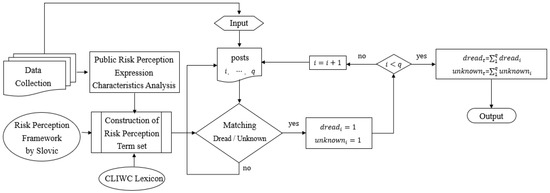
Figure 1.
The computation process of risk perception.
As shown in Figure 1, after constructing the term set, we matched the posts one by one based on whether the text contained dread and unknown words, and whether the post content included any word in the dread or unknown term set. The quantity was marked (+1) in the dread and unknown dimension accordingly. If there were q posts on day t, indicates the number of posts containing dread words in q posts on day t, and indicates the number of posts containing unknown words in q posts on day t. Finally, the results of and were output according to the matching process. Moreover, we further depicted the feature representation of risk perception, as shown in Figure 2.
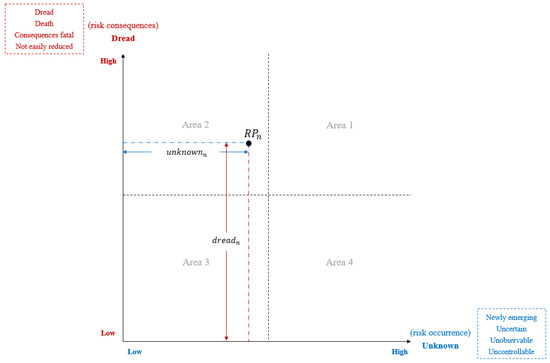
Figure 2.
Characteristic representation of risk perception.
Figure 2, from left to right, indicates a gradual increase in the perception of unknown; from bottom to top, it indicates a gradual increase in the perception of dread. Among them, the perception of unknown and dread is the largest in Area 1, and the perception of unknown and dread is the smallest in Area 3. then indicates the risk perception value on day t, which is calculated as follows.
Public risk perception in emergencies is an underlying psychological process that expresses the public’s fear of the serious consequences of risk and uncertainty about the probability of risk occurring. The crisis mapping model, on the other hand, characterizes the public’s response from an emotion-driven perspective, pointing out that emotions change continuously in response to changes in the external environment. At the same time, arousal theory illustrates both the critical role of emotions in the level of internal cognition and the ability of emotional types to activate cognition. Therefore, it is necessary to further analyze emotional characteristics during changes in risk perception so as to understand the performance characteristics of public risk perception in a comprehensive manner.
2.3. Analysis Method of Public Emotion Expression
2.3.1. Categorization of Emotion
Arousal theory emphasizes the moderating effect of emotions on cognition [15]. We next analyze the characteristics of emotion in risk perception by emotion classification.
Following the COVID-19 outbreak, public emotion changed as information was circulated. Through our observation of the data, the types of emotions that were most frequently expressed on social media platforms during our sample periods were positive, sad, fearful, and angry. Therefore, during the data-labeling process, we classified the obtained data into emotions according to five categories as follows: positive, sad, fearful, angry, and neutral. Table 2 presents the classification and description of emotions in this study.

Table 2.
Description of emotion categories and data examples in Weibo.
With respect to our emotion categories mentioned above (positive, sad, fearful, angry, and neutral), two graduate students participated in the labeling together, and we filtered out the data with different labels. At the same time, in order to overcome the problem of unbalanced categories within the sample for the next step of model training, we achieved equal classification of the five categories of emotions in the labeling process, i.e., 3300 items were labeled and filtered for each emotion category. Finally a total of 16,500 posts with emotion classification labels were obtained.
2.3.2. Construction of Emotion Classifier
Unlike text analysis methods for risk perception expressions, emotional expressions are often not straightforwardly able to be captured by words. In recent years, with the development of Natural Language Processing technology, the Bidirectional Encoder Representation from Transformers (BERT) model [24] of the deep dynamic representation method has been proposed, which has been widely used and well received. BERT pre-training is divided into two parts: the masked language model (MLM) and next sentence prediction (NSP). In our study, we employed a modified version of the BERT model, the Chinese-RBT3 pre-training model [25,26], to train the Chinese text in order to realize the emotion analysis of large-scale text data.
We randomly selected 13,750 pieces of data as the training set and 2750 pieces of data as the test set based on the 16,500 data sets obtained from manual annotation. The accuracy of the emotion classifier constructed using the Chinese-RBT3 pre-training model achieved 81.67% after training and testing. Furthermore, we input the large-scale dataset (the remaining 171,275 out of a total of 185,025 items) in this study into the model to predict the emotion types of the collected post texts.
2.4. VAR model
A vector autoregressive (VAR) model was employed to capture the dynamic relationship between risk perception and emotion. Compared with other analytical methods, the VAR model has several advantages: first, it can analyze the influential relationships between variables. Secondly, it can address the feedback bias of reverse causality, i.e., the current stage of emotion may affect the next stage of risk perception, which in turn causes a change in emotion in the next stage. Thus, the VAR model can simultaneously measure the dynamic and complex inter-influence relationships between different variables [22].
As shown in Equation (2), we analyzed the dynamic influence relationship between risk perception and emotions. The variables in the equation include the past values of each variable itself, past values of other variables, and error terms. The variable j denotes the maximum lag order; denotes the coefficient matrix; denotes the white noise error term; denotes the risk perception value at day t; and denotes the risk perception value at day t-j.
The analysis process of the VAR model includes the stationarity test, optimal lag length selection, model estimation and stability test, Granger causality test, and impulse response analysis [27]. The stationarity of the time series is an important requirement before performing dynamic analysis, and we adopted the augmented Dicker-Fuller (ADF) unit root test for testing variables. Further, we performed the determination of optimal lag length based on the Akaike Information Criterion (AIC), Hannan-Quinn Criterion (HQC), and Final Prediction Error (FPE). Through the impulse response analysis of the VAR model, we further understood the dynamic response patterns of different emotions and risk perception, and the two served as mutual signposts for a more comprehensive understanding of risk perception characteristics.
3. Results
3.1. Pubic Risk Perception and Emotional Characteristics on Social Media
Based on Equation (1), we calculated the public risk perception level as shown in Figure 3.
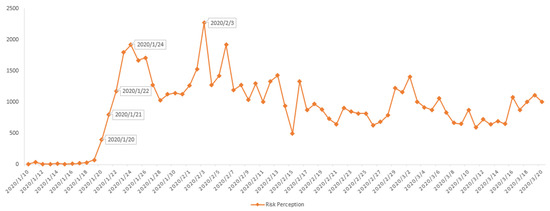
Figure 3.
Trend of Public Risk Perception.
As can be seen in Figure 3, in the early stages of the COVID-19 outbreak, public risk perception showed a sharp climb from 20 January onwards, and reached its first peak on 24 January and then again on 3 February, due to the scientific unknowns concerning the virus and the lack of knowledge of the risks. Comparing the data with epidemic events, we find that 23 January 2020 saw the most severe epidemic prevention measure, the lockdown of a large city with a population of 10 million people. This was a move unprecedented in recent history, and as can be seen from the data, this move quickly triggered a higher level of public risk perception.
Further, we characterized the performance of the “dread” and “unknown” dimensions of risk perception separately. As shown in Figure 4, the public expresses significantly more dread words than unknown words.
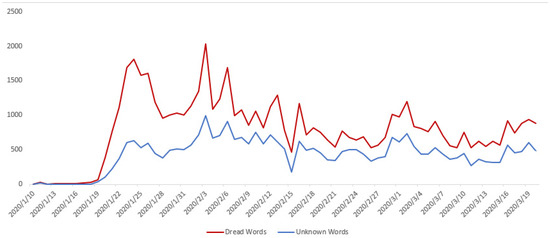
Figure 4.
Comparison of risk perception expression dimensions.
Table 3 shows the results of the statistical calculations. During our sample period (71 days in total), there were 800 posts expressing dread words on average per day, while there were 435 posts expressing unknown words on average per day. This shows that people were more inclined to express a dread mindset in post content, while expressions of uncertainty numbered only half of the dread expressions.

Table 3.
Expression characteristics of risk perception.
It can be seen that “dread” played a more dominant role in the shaping of risk perception than the unknown mindset. Next, we needed to further explore the emotional characteristics of the risk perception shaping process.
We calculated the emotion classification results from the emotion classification model, and further calculated the distribution of each of the five emotion categories. As shown in Figure 5, except for “neutral,” there were significantly more positive than negative emotions (fearful, sad, and angry) in posts.
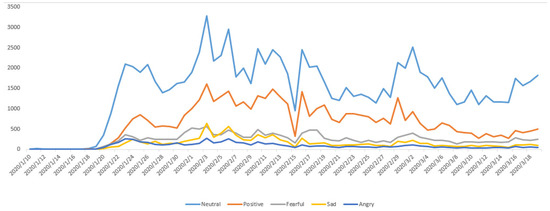
Figure 5.
Trends of five emotional categories in posts.
In terms of time, it can be seen that there were fewer positive emotions and more fearful, sad, and angry emotions at the beginning of the outbreak, and that these negative emotions may have resulted from people’s unfamiliarity with and concern about the severity of the outbreak, as well as the lack of timely and relevant prevention and control policies initially. After late February, negative emotions showed a more stable trend, as shown in Figure 5.
Table 4 presents the average of 1472 posts with neutral emotions, 651 posts with positive emotions, and 482 posts with negative emotions per day in our sample for the period of 71 days from January 10 to March 20. For negative emotions, fearful is the most frequent on average, followed by sad and angry. In addition, the minimum number of posts of neutral emotion is 6 posts per day and the maximum number of posts is 3275 posts per day.

Table 4.
Descriptive statistics of emotions distribution.
3.2. Dynamic Evolutionary of Risk Perception
A public health emergency is a continuous response process that requires health agencies to make timely and targeted responses based on changes in the life cycle of a crisis [22]. Crisis stages play a significant role in crisis response, as has been evaluated in relation to previous crises such as SARS [28] and Hurricane Katrina [29].
COVID-19 underwent several different stages during the outbreak period (i.e., our sample period), and we further explored the dynamic evolutionary characteristics of risk perception. Based on the course of the epidemic, we divided the sample period (10 January 2020–20 March 2020) into the following stages.
- Buildup Stage: 10 January 2020–20 January 2020
20 January 2020: The National Health Commission issued an announcement on the COVID-19 as a Class B infectious disease and the preventive adoption as Class A infectious diseases.
- Breakout Stage: 21 January 2020–4 February 2020
4 February 2020: the number of new confirmed cases on that day is less than the number of new confirmed cases on the previous day.
- Confrontation Stage: 5 February 2020–18 February 2020
18 February 2020: the number of new confirmed cases on that day is less than the number of newly cured cases on that day.
- Abatement Stage: 19 February 2020–20 March 2020
18 March 2020: For the first time, zero new indigenous confirmed cases were reported nationwide.
Based on the above stage division, we depicted the risk perception characteristics, as shown in Figure 6. During our sample period (71 days in total), there was a sudden increase and a gradual decrease in the level of public risk perception. The colors of the dots in Figure 6 represent risk perception at different stages. According to the distribution of risk perception characteristics, it can be seen that public’s dread and unknown about risk are high in the second stage (the red dots), while the third stage shows a decrease in dread, but the unknown is still high (the yellow dots). At the fourth stage, risk perception continues to remain high, similar to the third stage.
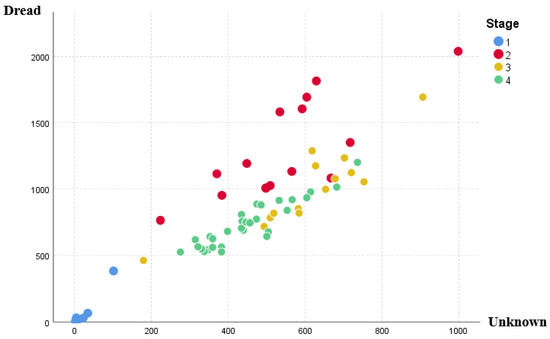
Figure 6.
Risk perception characteristics of different stages.
In order to observe the evolution of risk perception characteristics at different stages, we calculated the mean values of “dread” and “unknown” tendencies separately in each stage. As shown in Figure 7, risk perceptions showed a surge in the second stage, followed by a decreasing trend in the third and fourth stages. The tendency to express “dread” decreased and the tendency to express “unknown” increased from the second to the third stage. It is possible that after the outbreak stage, the public’s fear of the sudden emergence of infectious diseases had diminished, but due to the highly uncontrollable nature of the virus, the perception of the unknown was still increasing.

Figure 7.
Trends in risk perception characteristics of different stages.
Self-perception theory [30] emphasizes the dynamics of perceptual states, i.e., one’s previous risk perception affects one’s current risk perception. This explains, to some extent, why risk perception remained high even though the actual risk (new cases of COVID-19) had fell in the fourth period. Next, we further analyzed the mutual dynamic response relationship between perception and emotion.
3.3. Impulse Response Analysis of Risk Perception and Emotion
Through the analysis of risk perception and emotion characteristics in the time-series trend, a certain dynamic relationship was found between them. We further introduced the VAR model to investigate the relationship between the responses of different emotion types and risk perception.
The first step of the VAR model is to conduct a unit root test to avoid the phenomenon of “pseudo-regression”. We conducted an ADF unit root test for each variable in equation (2) after logarithmic processing, and the results are shown in Table 5. It can be seen that all the series reject the null hypothesis, indicating that they are stationary series.

Table 5.
Results of ADF unit root tests.
Next, we determined the lags of the VAR model based on various information criteria, namely, the likelihood ratio (LR), Akaike final prediction error (FPE), Akaike information criterion (AIC), Hannan-Quinn information criterion (HQIC), and Schwarz Bayesian information criterion (SBIC). Table 6 shows the test results of the information criterion, and the results of most of the criteria show the optimal lags to the first order of lag.

Table 6.
Information criteria used to select the lag period.
The main focus of the VAR model is the dynamic influence relationship between variables. The impulse response function measures the response of an endogenous variable to an error shock, revealing the dynamic changes in the interaction of variables over multiple time periods. We further analyzed the dynamic response process between public risk perception and emotion through the impulse response function. Figure 8 shows the impulse response function (IRF) results for different emotions on risk perception shocks, where the horizontal axis indicates the number of shock response periods and the vertical axis indicates the response of the dependent variable to the shock unit in the shock variable (i.e., the shock response function).
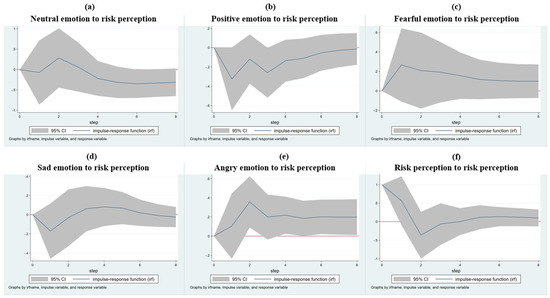
Figure 8.
Dynamic impulse response of emotions to public risk perception.
The gray area in Figure 8 indicates the confidence interval, which, if it always covers the y = 0 horizontal line, indicates that this shock impact is not significantly different from 0, meaning that there is no significant impact. Therefore, we can see that positive emotions, angry emotions, and risk perception itself have a significant effect on risk perception based on the performance of significance. From Figure 8b, it can be seen that positive emotions show a W-shaped pattern forming a negative impact effect on risk perception, i.e., the more positive emotions in the lagged period (i.e., the previous day), the lower the risk perception on the next day. As can be seen in Figure 8e, anger has a positive volatility impact on risk perception, showing an inverted V-shaped downward pattern, i.e., the more anger there is in the previous day, the higher the risk perception in the next day. Figure 8f depicts the dynamic effect of risk perception itself, showing a positive V-shaped effect, i.e., the higher the level of risk perception on the previous day, the higher the level of risk perception on the next day.
Figure 9 illustrates the IRF results of risk perception on different emotion shocks. Based on the performance of significance, it can be seen that risk perception has a significant impact on positive emotions only. The impact of risk perception on positive emotions shows a low-high-low negative fluctuating impact with an overall negative predominance.
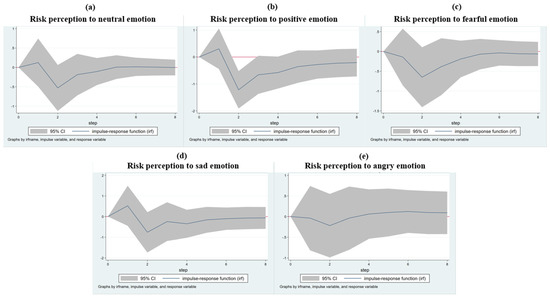
Figure 9.
Dynamic impulse response of public risk perception to emotions.
4. Discussion
4.1. Key Findings
First, it is the “dangerous” and “unfamiliar” characteristics of public health events that directly affect the level of public risk perception when an outbreak occurs. We thus explored the characteristics of the public’s risk perception on social media platforms through two dimensions (“dread” and “unknown”) and found that the public expressed more concerns about dread. It can be seen that dread plays a more important leading role in the shaping process of risk perception compared to the unknown mindset. Therefore, we further developed an in-depth analysis of emotional characteristics and found that the proportion of negative emotions suddenly increased after the outbreak of the epidemic, which verifies the content of the Behavioral Immune System (BIS theory) that negative emotions stimulate people’s self-protection and people tend to generate more negative emotions for self-protection in dangerous situations [31,32].
Secondly, the analysis of dynamic evolutionary characteristics of risk perception revealed that the public’s psychological state and attitude toward risk are sensitive to protective behaviors. Self-perception theory [30] suggests that people infer their perceptions through their previous behavior and the environment, and when the inference cues are not clear, they infer the perceived state as an observer based on the relevant cues. In other words, individuals dynamically adjust their perceptual states based on their observed behavior and that of others, and the adjusted perceptual states in turn have an impact on subsequent perceptions.
Finally, through the impulse response analysis based on a VAR model, we found a dynamic and synergistic relationship between positive emotions, angry emotions, and risk perceptions. It further illustrated that there is a certain mapping relationship between public emotions and risk perceptions in crisis situations, which verifies the conclusion that there is a certain relationship between perceptions and emotions in arousal theory [33].
4.2. Appropriate Risk Perception
The study enhanced our understanding of risk perception and emotional expression in emergency situations. Protection Motivation Theory (PMT) suggests that protective behavior is the result of a combination of threat and response assessments by people [34]. When the public perceives higher external risks, they tend to be more willing to adopt protective behaviors; that is, they are more motivated to protect themselves when they assess risks as more threatening than adaptive behaviors. In contrast, when the degree of risk perception is weak, the public’s motivation to engage in protective behaviors is not obvious, which can easily lead to noncompliance with protective behaviors in public health events, resulting in the rapid spread of the virus.
However, the level of public risk perception of an outbreak should not simply be viewed as “the higher the better.” A low level of risk perception may reduce individual awareness regarding protection; this may result, for example, in underestimating the degree of contagion and danger of the virus, not taking personal protective measures, deliberately concealing health status, and so on, which may compromise the effectiveness of outbreak prevention and control. However, a high level of risk perception will lead the public to take excessive protective measures and affect the maintenance of social order; for example, public anxiety about the risk of being infected may bring about consequences such as economic and health system collapse, unemployment, disrupted interpersonal relationships, and so on [35].
When a public emergency breaks out, it is important for people to correctly understand the risks and not to spread the epidemic because of inadequate protective measures; it is also important to reduce excessive stress reactions brought about by inappropriate perceptions. Therefore, we need to strengthen the regulation of changes in risk perceptions and keep abreast of fluctuations in public risk perceptions, so that we can develop effective policies for public health management and health communication to maintain an appropriate level of risk perception.
4.3. Implications
This research has several theoretical implications. First, we proposed a two-dimensional feature vector for risk perception (“dread” and “unknown”), constructed the risk perception term set about COVID-19, and proposed a method for calculating risk perception based on the two-dimensional feature vector. We quantitatively analyzed the characteristics of risk perception at different crisis stages based on this approach, extending the previous literature, which considered risk perception only as a static quantitative result. The analysis of the dynamic characteristics of risk perception will further help to explain the strength of the explanatory relationship between it and potential variables. Secondly, we revealed the dynamic interaction between emotion and risk perception based on the impulse response function (IRF) of the VAR model, which provides a richer perspective on emergency management and should consider the evolutionary law of extreme emotion and risk perception.
Our research also provides several practical implications. Since public risk perception is a key driver of public behavior, the dynamic characteristics of risk perception and emotion based on the monitoring of risk perception will help the government to develop appropriate emergency management and risk communication measures, which in turn will enable the management of infectious disease compliance behavior. For the occurrence of public emergencies, the government should pay attention to risk communication and provide reliable risk-revealing information, while also reducing unnecessary panic.
This study analyzed risk perception expression words and emotion characteristics and found that emotions are important expression characteristics of public risk perceptions, and further concluded that there is a dynamic and synergistic relationship between angry emotions, positive emotions, and risk perceptions. Studies have pointed out that content published by social media users can be used as a valid pathway for psychometric measures. This suggests that during the COVID-19 epidemic, the government risk communication process can observe the changing trend of risk perception through the changes of these two types of extreme emotions, and then guide public risk perception by directing emotions, so that people can correctly view the risk and control the risk perception within a reasonable range through timely and reasonable effective guidance.
When a public health emergency breakout occurs, the government should increase public courage and determination, raise public risk awareness, and motivate people to take effective protective measures against the outbreak. It has been noted that detailed information can increase people’s risk perceptions and promote protective behaviors. Thus, active risk communication, as well as conveying positive educational messages, can lead to more appropriate protective behaviors among the public. Due to the need for normalized epidemic prevention and control, the government also needs to further improve the monitoring and early warning system of public risk perception according to the dynamic development and changes of risk perception, to take effective risk perception de-escalation measures at different stages of public health events at the right time, and to introduce targeted emergency management policies.
4.4. Limitations
This study, however, has some limitations. First, the completeness and bias of the dataset is a major limitation considering the freedom of users to post and delete posts. Therefore, future related studies can use sufficiently rich samples, such as data samples obtained from more platforms or based on more keyword collections, which may yield characteristic patterns about more dimensions of risk perception. Second, this study did not distinguish the individual differences in the process of expressing risk perceptions among Weibo users with different influences. Since Weibo users with different numbers of followers may bring different information effects, and since risk perceptions are influenced by their own factors such as personal identity, these can be distinguished and given weight in future considerations of the process of measuring risk perceptions. Third, this study conducted research on Chinese social media users only. Future studies could expand data sets to explore more valuable findings, such as the impact of emergency background, the comparison of public risk perception in the absence of public crisis, and the difference of public risk perception in different countries and regions in global public health emergencies. Future studies can be analyzed from mainstream social media in different regions. Finally, future research can further improve the emotion classification algorithm to enhance the accuracy of the classifier and further improve the objective validity of the experimental results.
5. Conclusions
In this study, we proposed the measuring method of risk perception based on two dimensions (“dread” and “unknown”) during the COVID-19 pandemic. We calculated the level of public risk perception by term set–matching, and found that emotional expression is an important feature in risk perception. We further constructed a five-category model of emotions based on the BERT algorithm, and analyzed the dynamic response relationships between different emotion types and risk perception through the VAR model. Finally, we concluded that positive emotions, angry emotions, and risk perceptions themselves have significant mapping response relationships with the development trend of risk perceptions. This study further strengthens the understanding of public risk perception in public health emergencies and provides a strategic basis for government risk communication emergency management.
Author Contributions
T.L.: conceptualization, methodology, software, visualization, formal analysis, data curation, writing. X.W.: manuscript revision, methodology. Y.Y.: conceptualization, Methodology, formal analysis. G.Y.: conceptualization, writing, funding acquisition. X.T.: data curation, methodology. All authors have read and agreed to the published version of the manuscript.
Funding
This research was funded by the National Natural Science Foundation of China (Grant No. 72074060).
Data Availability Statement
Data supporting the findings of this study were available from authors on request.
Acknowledgments
The authors would like to thank Zhiwei Data Sharing Platform (http://university.zhiweidata.com/, accessed on 13 November 2022) for our data support.
Conflicts of Interest
The authors declare that the research was conducted in the absence of any commercial or financial relationships that could be construed as a potential conflict of interest.
References
- Gu, J.W.; He, R.; Wu, X.H.; Tao, J.; Ye, W.H.; Wu, C.M. Analyzing Risk Communication, Trust, Risk Perception, Negative Emotions, and Behavioral Coping Strategies During the COVID-19 Pandemic in China Using a Structural Equation Model. Front. Public Health 2022, 10, 843787. [Google Scholar] [CrossRef] [PubMed]
- Slovic, P. Perception of Risk. Science 1987, 236, 280–285. [Google Scholar] [CrossRef]
- Siddiqui, S.; Qamar, A.H. Risk Perception and Protective Behavior in the Context of COVID-19: A Qualitative Exploration. Asian Bioeth. Rev. 2021, 13, 401–420. [Google Scholar] [CrossRef] [PubMed]
- Wachinger, G.; Renn, O.; Begg, C.; Kuhlicke, C. The Risk Perception Paradox-Implications for Governance and Communication of Natural Hazards. Risk Anal. 2013, 33, 1049–1065. [Google Scholar] [CrossRef] [PubMed]
- Chung, J.E. A Smoking Cessation Campaign on Twitter: Understanding the Use of Twitter and Identifying Major Players in a Health Campaign. J. Health Commun. 2016, 21, 517–526. [Google Scholar] [CrossRef]
- Liu, B.F.; Kim, S.J.P.R.R. How organizations framed the 2009 H1N1 pandemic via social and traditional media: Implications for U.S. Health Commun. 2011, 37, 233–244. [Google Scholar] [CrossRef]
- Vieweg, S.; Hughes, A.L.; Starbird, K.; Palen, L. Microblogging during Two Natural Hazards Events: What Twitter May Contribute to Situational Awareness. In Proceedings of the CHI2010: Proceedings of the 28th Annual Chi Conference on Human Factors in Computing Systems, VOLS 1–4, Atlanta, GA, USA, 10–15 April 2010; pp. 1079–1088. [Google Scholar]
- Duan, T.; Sun, Z.; Shi, G. Sustained Effects of Government Response on the COVID-19 Infection Rate in China: A Multiple Mediation Analysis. Int. J. Environ. Res. Public Health 2021, 18, 12422. [Google Scholar] [CrossRef]
- Fung, I.C.H.; Fu, K.W.; Ying, Y.; Schaible, B.; Hao, Y.; Chan, C.H.; Tse, Z.T.H. Chinese social media reaction to the MERS-CoV and avian influenza A(H7N9) outbreaks. Infect. Dis. Poverty 2013, 2, 1–12. [Google Scholar] [CrossRef]
- Feng, Y.; Tong, Q. Exploring the Mediating Role of Situation Awareness and Crisis Emotions Between Social Media Use and COVID-19 Protective Behaviors: Cross-Sectional Study. Front. Public Health 2022, 10, 1024. [Google Scholar] [CrossRef]
- Maunder, R.; Hunter, J.; Vincent, L.; Bennett, J.; Peladeau, N.; Leszcz, M.; Sadavoy, J.; Verhaeghe, L.M.; Steinberg, R.; Mazzulli, T. The immediate psychological and occupational impact of the 2003 SARS outbreak in a teaching hospital. Can. Med. Assoc. J. 2003, 168, 1245–1251. [Google Scholar]
- Tam, C.W.C.; Pang, E.P.F.; Lam, L.C.W.; Chiu, H.F.K. Severe acute respiratory syndrome (SARS) in Hong Kong in 2003: Stress and psychological impact among frontline healthcare workers. Psychol. Med. 2004, 34, 1197–1204. [Google Scholar] [CrossRef]
- Li, W.; Yang, Y.; Liu, Z.H.; Zhao, Y.J.; Zhang, Q.; Zhang, L.; Cheung, T.; Xiang, Y.T. Progression of Mental Health Services during the COVID-19 Outbreak in China. Int. J. Biol. Sci. 2020, 16, 1732–1738. [Google Scholar] [CrossRef]
- Lerner, J.S.; Keltner, D. Beyond valence: Toward a model of emotion-specific influences on judgement and choice. Cogn. Emot. 2000, 14, 473–493. [Google Scholar] [CrossRef]
- Berger, J.; Milkman, K.L. What Makes Online Content Viral. J. Mark. Res. 2012, 49, 192–205. [Google Scholar] [CrossRef]
- Wilson, R.S.; Zwickle, A.; Walpole, H. Developing a Broadly Applicable Measure of Risk Perception. Risk Anal. 2019, 39, 777–791. [Google Scholar] [CrossRef] [PubMed]
- Peters, E.M.; Burraston, B.; Mertz, C.K. An emotion-based model of risk perception and stigma susceptibility: Cognitive appraisals of emotion, affective reactivity, worldviews, and risk perceptions in the generation of technological stigma. Risk Anal. 2004, 24, 1349–1367. [Google Scholar] [CrossRef]
- Slovic, P.; Finucane, M.L.; Peters, E.; MacGregor, D.G. The affect heuristic. Eur. J. Oper. Res. 2007, 177, 1333–1352. [Google Scholar] [CrossRef]
- Slovic, P.; Peters, E. Risk perception and affect. Curr. Dir. Psychol. Sci. 2006, 15, 322–325. [Google Scholar] [CrossRef]
- Armfield, J.M. Cognitive vulnerability: A model of the etiology of fear. Clin. Psychol. Rev. 2006, 26, 746–768. [Google Scholar] [CrossRef] [PubMed]
- Setbon, M.; Raude, J.; Fischler, C.; Flahault, A. Risk perception of the "mad cow disease" in France: Determinants and consequences. Risk Anal. 2005, 25, 813–826. [Google Scholar] [CrossRef]
- Xu, L.; Qiu, J.; Gu, W.; Ge, Y. The Dynamic Effects of Perceptions of Dread Risk and Unknown Risk on SNS Sharing Behavior During EID Events: Do Crisis Stages Matter? J. Assoc. Inf. Syst. 2020, 21, 545–573. [Google Scholar]
- Huang, C.L.; Chung, C.K.; Hui, N.; Lin, Y.C.; Pennebaker, J.W. Development of the Chinese linguistic inquiry and word count dictionary. Chin. J. Psychol. 2012. [Google Scholar] [CrossRef]
- Devlin, J.; Chang, M.W.; Lee, K.; Toutanova, K. BERT: Pre-training of Deep Bidirectional Transformers for Language Understanding. In Proceedings of the 2019 Conference of the North American Chapter of the Association for Computational Linguistics: Human Language Technologies, Minneapolis, MN, USA, 2–7 June 2019; pp. 4171–4186. [Google Scholar]
- Cui, Y.; Che, W.; Liu, T.; Qin, B.; Yang, Z. Pre-Training with Whole Word Masking for Chinese BERT. IEEE/ACM Trans. Audio Speech Lang. Process. 2019, 29, 3504–3514. [Google Scholar] [CrossRef]
- Liu, Y.; Ott, M.; Goyal, N.; Du, J.; Joshi, M.; Chen, D.; Levy, O.; Lewis, M.; Zettlemoyer, L.; Stoyanov, V. RoBERTa: A Robustly Optimized BERT Pretraining Approach. arXiv 2019, arXiv:1907.11692. [Google Scholar]
- Adomavicius, G.; Bockstedt, J.; Gupta, A. Modeling supply-side dynamics of IT components, products, and infrastructure: An empirical analysis using vector autoregression. Inf. Syst. Res. 2012, 23, 397–417. [Google Scholar] [CrossRef]
- Leidner, D.E.; Pan, G.; Pan, S.L. The role of IT in crisis response: Lessons from the SARS and Asian Tsunami disasters. J. Strateg. Inf. Syst. 2009, 18, 80–99. [Google Scholar] [CrossRef]
- Pan, S.L.; Pan, G.; Leidner, D.E. Crisis Response Information Networks. J. Assoc. Inf. Syst. 2012, 13, 31–56. [Google Scholar] [CrossRef]
- Bhattacherjee, A. Understanding information systems continuance: An expectation-confirmation model. MIS Q. 2001, 25, 351–370. [Google Scholar] [CrossRef]
- Mortensen, C.R.; Becker, D.V.; Ackerman, J.M.; Neuberg, S.L.; Kenrick, D.T. Infection Breeds Reticence: The Effects of Disease Salience on Self-Perceptions of Personality and Behavioral Avoidance Tendencies. Psychol. Sci. 2010, 21, 440–447. [Google Scholar] [CrossRef]
- Schaller, M.; Murray, D.R. Pathogens, personality, and culture: Disease prevalence predicts worldwide variability in sociosexuality, extraversion, and openness to experience. J. Personal. Soc. Psychol. 2008, 95, 212–221. [Google Scholar] [CrossRef]
- Li, L.; Wang, Z.; Zhang, Q.; Wen, H. Effect of anger, anxiety, and sadness on the propagation scale of social media posts after natural disasters. Inf. Process. Manag. 2020, 57, 102313. [Google Scholar] [CrossRef]
- Rippetoe, P.A.; Rogers, R.W. Effects of components of protection-motivation theory on adaptive and maladaptive coping with a health threat. J. Personal. Soc. Psychol. 1987, 52, 596–604. [Google Scholar] [CrossRef] [PubMed]
- Brailovskaia, J.; Margraf, J. The relationship between burden caused by coronavirus (COVID-19), addictive social media use, sense of control and anxiety. Comput. Hum. Behav. 2021, 119, 106720. [Google Scholar] [CrossRef] [PubMed]
Disclaimer/Publisher’s Note: The statements, opinions and data contained in all publications are solely those of the individual author(s) and contributor(s) and not of MDPI and/or the editor(s). MDPI and/or the editor(s) disclaim responsibility for any injury to people or property resulting from any ideas, methods, instructions or products referred to in the content. |
© 2023 by the authors. Licensee MDPI, Basel, Switzerland. This article is an open access article distributed under the terms and conditions of the Creative Commons Attribution (CC BY) license (https://creativecommons.org/licenses/by/4.0/).